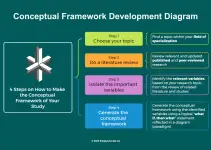Updated | September 22, 2025
The research objective of a research proposal or scientific article defines the direction or content of a research investigation. Without the research objectives, the proposal or research paper is in disarray. It is like a fisherman riding on a boat without any purpose and with no destination in sight. Therefore, at the beginning of any research venture, the researcher must be clear about what he or she intends to do or achieve in conducting a study.
How do you define the objectives of a study? What are the uses of the research objective? How would a researcher write this essential part of the research? This article aims to provide answers to these questions.
Table of Contents
Definition of a Research Objective
A research objective describes, in a few words, the result of the research project after its implementation. It answers the question,
“What does the researcher want or hope to achieve at the end of the research project.”
The research objective provides direction to the performance of the study.
What are the Uses of the Research Objective?
The uses of the research objective are enumerated below:
- serves as the researcher’s guide in identifying the appropriate research design,
- identifies the variables of the study, and
- specifies the data collection procedure and the corresponding analysis for the data generated.
The research design serves as the “blueprint” for the research investigation. The University of Southern California describes the different types of research design extensively. It details the data to be gathered, data collection procedure, data measurement, and statistical tests to use in the analysis.
The variables of the study include those factors that the researcher wants to evaluate in the study. These variables narrow down the research to several manageable components to see differences or correlations between them.
Specifying the data collection procedure ensures data accuracy and integrity. Thus, the probability of error is minimized. Generalizations or conclusions based on valid arguments founded on reliable data strengthens research findings on particular issues and problems.
In data mining activities where large data sets are involved, the research objective plays a crucial role. Without a clear objective to guide the machine learning process, the desired outcomes will not be met.
How is the Research Objective Written?
A research objective must be achievable, i.e., it must be framed keeping in mind the available time, infrastructure required for research, and other resources.
Before forming a research objective, you should read about all the developments in your area of research and find gaps in knowledge that need to be addressed. Readings will help you come up with suitable objectives for your research project.
5 Examples of Research Objectives
The following examples of research objectives based on several published studies on various topics demonstrate how the research objectives are written:
- This study aims to find out if there is a difference in quiz scores between students exposed to direct instruction and flipped classrooms (Webb and Doman, 2016).
- This study seeks to examine the extent, range, and method of coral reef rehabilitation projects in five shallow reef areas adjacent to popular tourist destinations in the Philippines (Yeemin et al., 2006).
- This study aims to investigate species richness of mammal communities in five protected areas over the past 20 years (Evans et al., 2006).
- This study aims to clarify the demographic, epidemiological, clinical, and radiological features of 2019-nCoV patients with other causes of pneumonia (Zhao et al., 2020).
- This research aims to assess species extinction risks for sample regions that cover some 20% of the Earth’s terrestrial surface.
Finally, writing the research objectives requires constant practice, experience, and knowledge about the topic investigated. Clearly written objectives save time, money, and effort.
Once you have a clear idea of your research objectives, you can now develop your conceptual framework which is a crucial element of your research paper as it guides the flow of your research. The conceptual framework will help you develop your methodology and statistical tests.
I wrote a detailed, step-by-step guide on how to develop a conceptual framework with illustration in my post titled “Conceptual Framework: A Step by Step Guide on How to Make One.“
References
Evans, K. L., Rodrigues, A. S., Chown, S. L., & Gaston, K. J. (2006). Protected areas and regional avian species richness in South Africa. Biology letters, 2(2), 184-188.
Thomas, C. D., Cameron, A., Green, R. E., Bakkenes, M., Beaumont, L. J., Collingham, Y. C., … & Hughes, L. (2004). Extinction risk from climate change. Nature, 427(6970), 145-148.
Webb, M., & Doman, E. (2016). Does the Flipped Classroom Lead to Increased Gains on Learning Outcomes in ESL/EFL Contexts?. CATESOL Journal, 28(1), 39-67.
Yeemin, T., Sutthacheep, M., & Pettongma, R. (2006). Coral reef restoration projects in Thailand. Ocean & Coastal Management, 49(9-10), 562-575.
Zhao, D., Yao, F., Wang, L., Zheng, L., Gao, Y., Ye, J., Guo, F., Zhao, H. & Gao, R. (2020). A comparative study on the clinical features of COVID-19 pneumonia to other pneumonias, Clinical Infectious Diseases, ciaa247, https://doi.org/10.1093/cid/ciaa247
© 2020 March 23 P. A. Regoniel




thank you for clarification
This is excellent